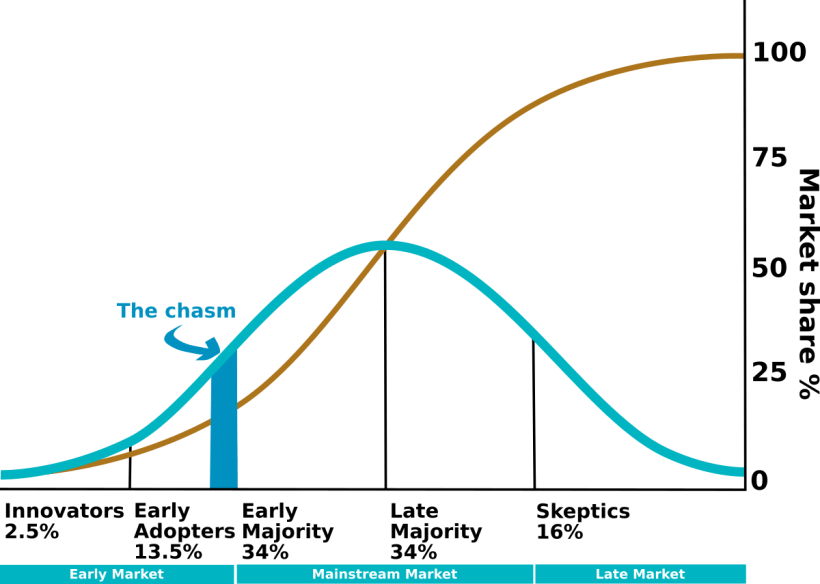Agile development: On for the ride, on for the slide
Anyone who’s set out to build a startup knows it’s often a life of uncertainty, uneasiness, despair even. But it’s also a life of great excitement and achievement. You may ask, what does Agile development have to do with it? I hear you.

Now, depending on what you have in mind, when you’re planning to do it, how everything comes to place and where your entry points are, your entire plan may prove to be ingenious or just a flop. That’s because any idea coming to life needs proper timing, the right place, great implementation, and the right people to buy into it. Otherwise, more often than not, you’re not getting there. Agile development might be just the thing you need.
Beware the zombie startups
A common misunderstanding in the ways of a startup is that a great plan will get you where you want to be, make your dreams come true. It may, but then again who can be sure? While the act of planning is extremely valuable, an actual plan is often of no value. The point being, a startup is a very uncertain place to be. Partly, this is the reason why it’s so interesting. You need to make assumptions and try to validate them, each step of the way. You need to make heads or tails from tons of data, before you are able to find the right direction for your newly found business.
Now, if you somehow manage to miss all that in the greater picture, a world of problems may be waiting for you around the corner. And they will try to turn you into a zombie. That’s a state of passive reaction to anything that happens around you. In fact, so much so, that your startup may already be on the death row without you even knowing it. Agile development or not, there may not be much you can do at this point.
The early adopter chasm
Most startups miss that point. Everyone will start by talking to people about their problems and needs, drafting out a high level plan for product development. Then some early adopters may come aboard, as expected. We may even invite them to take part in our board of consultants, for some extra speed in discovering our feature set. And that’s great!
But alas, it’s not enough. See, once you’ve reached critical mass with your early adopters, repeatable sales cycle and all, you’re on a crossroads. You may be tempted to get your departments setup for sales and marketing, in hope they will help you make the transition to mainstream. You may increase your cash burn rate out of sensible boundaries. Well, don’t do it! First, you need to consider your market type. If it’s not an existing market, you’re going to be in for some ride. And maybe a slide right to rock bottom.
A re-segmented market, or a new market are bound to call for much greater efforts in going mainstream. You see, both these types feature a much greater chasm between early adopters and mainstream customers. In fact they’re so different, you may need to rethink your entire marketing and sales strategy. The actual business model that has a chance to work may be insanely different than what you have in your hands right now. So, mind the gap! Or, the chasm, rather.

Don’t be a zombie, stranger!
In the unlikely event that you’re blinded by early success with early adopters, consider this:
How much the same are your early adopters, as the mainstream customers you’re aiming for?
That is to say, more startups than we can count ended up blindly following the numbers, while unbeknownst to them, they were headed for the cliffs. If your mainstream audience is considerably different than your early adopters and you fail to understand the problem and amend the situation, your existing business model will eventually lead you to denial and a consecutive zombie state of passive reactions.
Being nice is bad for business
Culture and your brand
Being nice is a predominantly cultural thing. It’s a way of life. Abiding by your cultural treats throughout your company’s operations is important. But consider this; having a mission and core values to help define your daily routine will probably convince people come work for you. It won’t help them decide whether to buy from you or not.
Once you’ve gained some traction and you happily see new customers coming on board every day or so, you may decide it’s high time you got your brand going. And it’s absolutely reasonable to do so. A good brand will help accelerate your sales cycles, which is great. It may even produce some well earned virality effect. But think about it; how will this actually help you grow your customer base?
The brand asset
Here’s a somewhat scary thought. Isn’t it possible that people are fully aware of your brand but still won’t buy from you? If so, why do you think your company might find itself against this odd impasse? Well, as Simon Sinek so eloquently put it, “people don’t really buy what you do, they buy why you do it.”
What does this mean then? Well, if you know the reason people buy from you, and not from your competition, you’ve got what we call a brand asset. It can only get you so far in sales. Success is a little more difficult to reach. To cut a long story short, you need a brand personality to go with your brand asset. Your brand personality is unequivocally connected to your culture. Do you see where this is going?
The brand personality
People may know of your brand. But do they believe in it? Do they trust you? That’s a tough call. But since this is the way to get them to buy, there must be something you can do to convince them. Your company’s collective culture will shape a virtual character, much like a real person, with whom customers will be able to communicate. This way, regardless of whoever picks up the phone in pre-sales or after sales support, all customers perceive the added value of your brand personality.
What essentially happened here is that you showed people what your culture is. In turn, they chose to come on board and buy from you, or they didn’t. The difference is, if they did, some of them will probably become your free marketeers, telling friends and family about you. There’s your “virality” factor for you! If you can develop this well enough, you’ll be on your way to the fast track.
Consciousness
All this sounds great, but why is being nice a bad thing then? Well, it depends on your perspective. It could be bad for your staff, or it could be bad for business. Let me elaborate.
Goals are better, in business
I’m sure you started this whole startup thing of yours with the best of intentions. I’m even sure you’ve tried your best to befriend everyone in your staff, understand them and crew for them. You wanted the best possible work environment you could have, right? Well, that’s great, but did you balance it well enough to get a healthy collaboration or of it?
Now, you may think I speak in riddles. Please, let me explain. There is the best work environment that you can get with mission, common goals, love of what you’re doing, collaboration, camaraderie. And then there’s such a thing as the best work environment money can buy. Games, activities, events, eccentricities and whatnot. Sure, all this is really nice of you to provide for everyone. It’s entirely obvious it is done with the best of intentions. But you need to ask yourself; Will it help you achieve what you were aiming for if you lack any or all of the above? Does it seem plausible?
Money makes business difficult
Well, abundance of capital does make people slow. This means they may never think to optimize their operations on account of viability. That’s a drawback, a deadlock even – at least when you have a limited time window. And while there is cash, your runway may be inherently cut shorter. Having too much money, too little focus or no goals will keep you from realizing you’re in trouble. And that’s something to be cautious about.
Drop the niceties – externally
Whether you kicked this thing of as a developer working on your own product, or as a master of merely the business aspects, know this; you need to know where “nice” stops. I’ll try to explain this by example.
Say you’ve finally built a service your early adopters love. Say you’ve earned yourself enough reaction to make you and your team believe you stand a good chance in the mainstream market. Pre-sales support converts prospects to customers. Your sales process is optimized and has started to yield some quite satisfactory results. But, as expected, there are issues to be resolved and you need valuable feedback from your customers. Everything is allowed.
The flaw
Can you see what is potentially wrong with this picture? Being the nice team that you are, this tactics may blast your after sales support workload to the moon. You’ll want (or absolutely need) each and every customer to remain happy. A noble notion, I’ll admit. But it’s a drag and you risk burning all your cash in doing just that. This kind of risk is not that high if you stop trying to be that nice. But, how on Earth are you going to do that?
Simple; try to find out which types of customers are the most happy right now. Gather enough information about them, so that you can describe them and their use cases. Then, all you need to do is go for these “personas” throughout your addressable market. This way, you’ll have much less unhappy customers to tend to. You ought to be able to focus your efforts much more efficiently.
Less is more
Yes, that old, overused adage. So true though, isn’t it? In our case, less means “keep it simple”. Simplification brings focus. Focus brings productivity. Productivity saves time and effort – and money. Lack of too much cash brings more focus and a sense of urgency and importance you might never have enjoyed otherwise. Think about it!
Agile development: it’s worth your while
If you’re wondering how in the wild wild world of startups you could fix this, I’m glad you asked. Agile development (or processing) might be your answer. At least if you’re in the SaaS market.
What is Agile?
It’s a set of principles — a manifest. One that helps you organize and manage your project for minimum effort, maximum learning and continuous improvement. That sounds a bit on the “Lean” side, but it’s also true. Agile development allows you to be spry enough, so that you can work in continuous deployment cycles, learn what works and what doesn’t, make improvements and hit the next cycle, the Lean way.
Depending on the type of project you’re working on, you can use the variation (framework) of Agile development that is the most helpful. That is, in development and in operations alike. In the world of SaaS, we tend to use Scrum as our basic Agile development variation. In all probability, the most plausible reason for that is probably that there are quite a few Scrum-based tools out there for us to choose from, which will accommodate our needs regarding development, operations and pre-sales or after-sales support, altogether. Just what we need.
Why use Agile development?
Because relentless, continuous deployment. Yes, that’s right. I champion continuous development, as far as speed is concerned. Which, essentially facilitates continuous deployment.
Running a startup is not an exact science; not by a long shot. Having said that, no one ever said we can’t use some kind of scientific method to learn what we need. And that’s exactly what we’re aiming for. Running swift cycles of development, testing, learning and reiterating to make it better. All this allows us to gradually test and optimize our business model, eventually validating and consolidating it’s 9 building blocks, ensuring soundness of processes and overall viability. That’s Agile development for you.
After all, remember that your currency in early stages is knowledge, not money. That’s the most prudent way to go. It’s the closest thing you’ll have to a safety net.
TL;DR
If you set out to build your startup based on a leap of faith, you should try to validate that initial hypothesis as soon as you can. Try to validate as many of the blocks in your business model as you can, as early as possible. Securing the viability of your business model is of paramount importance in finding your way to success.
Denial is not at all helpful when you’ve discovered that little unwelcome bit of information that may only mean more difficulties. The sooner you discover it, the lesser of a problem you’ll have to deal with. So, go ahead and deal with it. If you don’t, you’re setting up yourself and your team for a bumpy ride. And it’s the perfect predicament to lead you directly into a zombie state.
So, less is more, indeed – in our case too! Focus your efforts, maximize your learning and continuously reiterate to improve on what you have at hand. If SaaS is your game, Agile development is your weapon of choice. Use it! It’s your choice, of course. Either way, since you’re on for the ride, you’re on for the slide!
